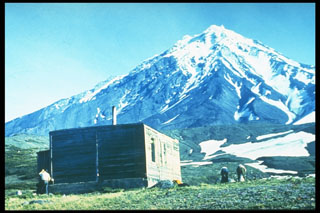Report on Koryaksky (Russia) — 24 December-30 December 2008
Smithsonian Institution / US Geological Survey
Weekly Volcanic Activity Report, 24 December-30 December 2008
Managing Editor: Sally Sennert.
Please cite this report as:
Global Volcanism Program, 2008. Report on Koryaksky (Russia) (Sennert, S, ed.). Weekly Volcanic Activity Report, 24 December-30 December 2008. Smithsonian Institution and US Geological Survey.
Koryaksky
Russia
53.321°N, 158.712°E; summit elev. 3430 m
All times are local (unless otherwise noted)
KVERT reported that during 23-24 December gas-and-steam plumes from Koryaksky containing a small amount of ash were detected on satellite images. On 24 December observers from the Nalychevo valley reported that a dark plume rose 200-300 m from a fumarolic vent (about 3 km a.s.l.) on the NW flank of Koryaksky and a boom was heard later that night. Ash plumes detected in satellite imagery on 25 December drifted about 200 km NE. On 28 December, KVERT raised the Alert Level to Orange and reported that a Vulcanian eruption was occurring. Ash plumes rose to an altitude of 4 km (13,200 ft) a.s.l. and drifted NW.
Geological Summary. The large symmetrical Koryaksky stratovolcano is the most prominent landmark of the NW-trending Avachinskaya volcano group, which towers above Kamchatka's largest city, Petropavlovsk. Erosion has produced a ribbed surface on the eastern flanks of the 3430-m-high volcano; the youngest lava flows are found on the upper W flank and below SE-flank cinder cones. Extensive Holocene lava fields on the western flank were primarily fed by summit vents; those on the SW flank originated from flank vents. Lahars associated with a period of lava effusion from south- and SW-flank fissure vents about 3900-3500 years ago reached Avacha Bay. Only a few moderate explosive eruptions have occurred during historical time, but no strong explosive eruptions have been documented during the Holocene. Koryaksky's first historical eruption, in 1895, also produced a lava flow.

